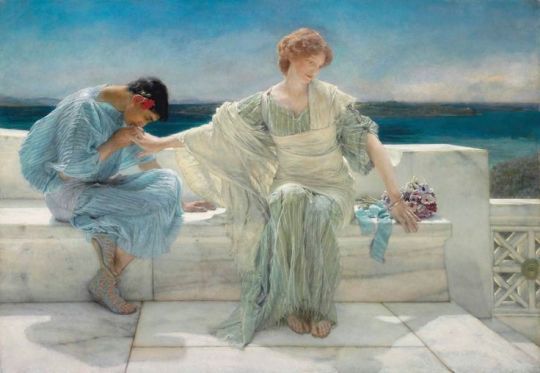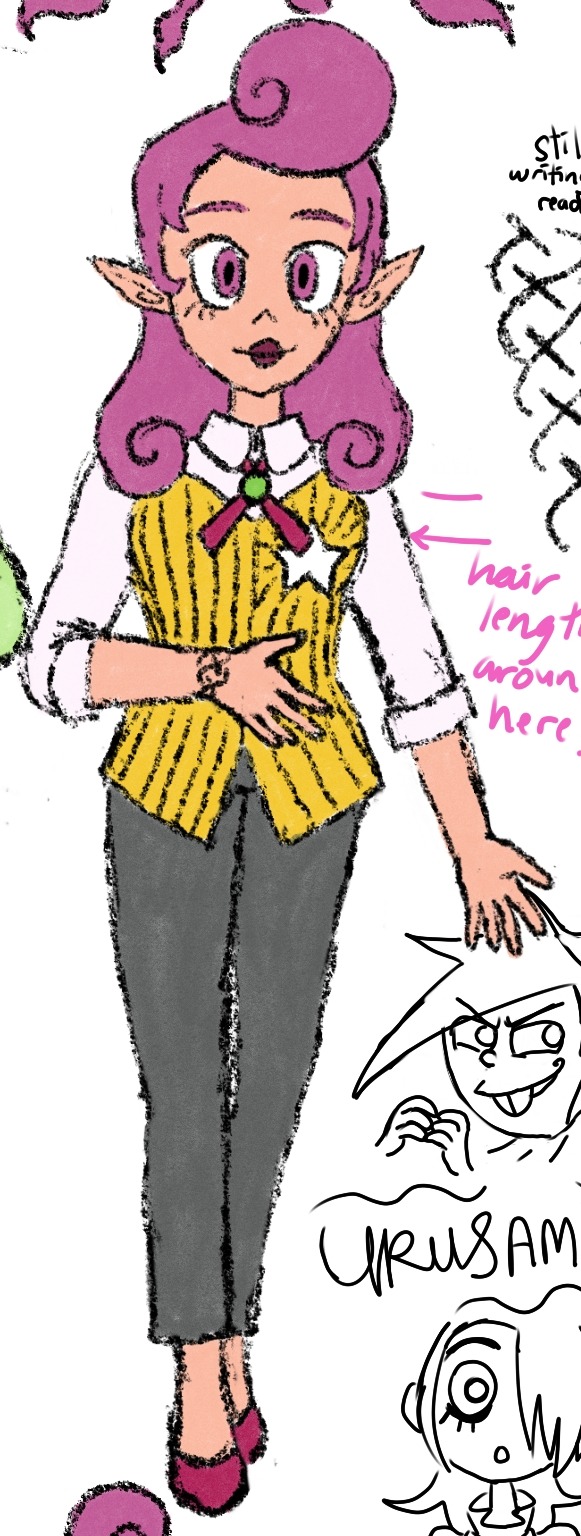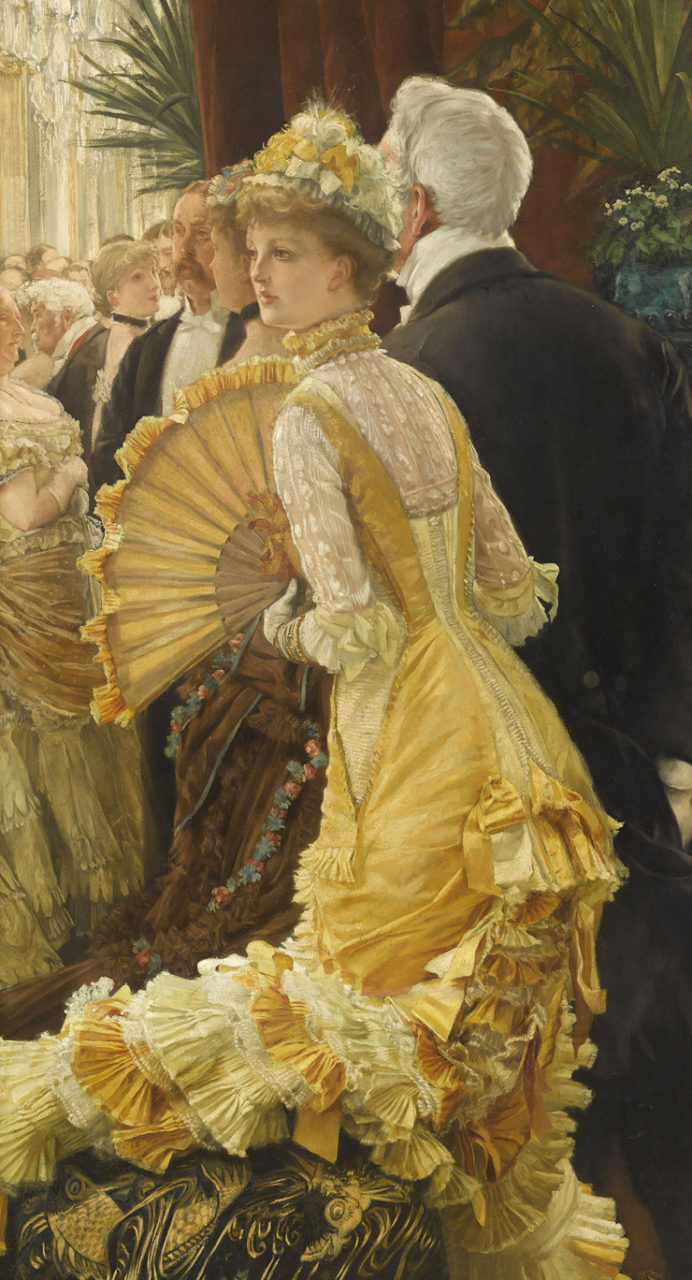#Victorian painter
Explore tagged Tumblr posts
Photo


Francis Bernard Dicksee, “The Two Crowns” & detail, 1900, oil on canvas. (1853 - 1928), English Victorian painter and illustrator known for his paintings of dramatic and historical literature, legends, and women portraits.
#francis bernard dicksee#the two crowns#detail#1900#oil on canvas#oil painting#painting#art#classic art#uk artist#victorian painter#historical#public domain#women#portraits
219 notes
·
View notes
Text

Ask Me No More
Artist: Lawrence Alma-Tadema (British, 1836–1912)
Date: 1906
Medium: Oil on canvas
Collection: Property of a European collector
Ask Me No More
'Ask me no more: thy fate and mine are seal'd: I strove against the stream and all in vain: Let the great river take me to the main: No more, dear love, for at a touch I yield.' Alfred, Lord Tennyson, The Princess.
'Ask me no more', which takes its title from a poem by the Poet Laureate Alfred Lord Tennyson, is a quintessential Alma-Tadema subject. In fact he treated it so often that it is probably the one with which he is most closely associated: a pair of lovers seated on a marble bench overlooking the Mediterranean Sea. The sun always shines in these pictures, although it never seems oppressively hot; and the lovers are invariably shown in a state of emotional anticipation rather than succumbing to passion itself. As Vern Swanson, the leading authority on Alma-Tadema, states in his catalogue raisonné of the artist's paintings, love-making is shown not 'at the point of climax, but rather earlier, when the tension is mounting.
A trademark feature of the painting is the marble bench. Alma-Tadema had made a specialty of painting marble since the late 1850s, and it had become one of his most celebrated accomplishments, endlessly commented on in reviews and even joked about in Punch. Dutch artists had always excelled at still-life, and Alma-Tadema's marble-painting is in this tradition. The same skill emerges in the way he handles flowers, as 'Ask me no more' also demonstrates. But the exquisitely rendered bunch of anemones does more than testify to the painter's virtuoso technique. Evidently a tribute from the youth to his sweetheart, it adds a touch of poignancy to the narrative. It is also a vital compositional element, placing an accent precisely where it is needed, and it provides a focal point for the colour scheme, a subtle interplay of blues, mauves and creams balanced against the pale aquamarine of the girl's dress.
This chromatic harmony is enhanced by the pearly light that pervades the scene, coming from behind the figures to create a contre-jour effect and cast delicate shadows onto the marble pavement. In 1884 Alma-Tadema had taken over 17 Grove End Road, St John's Wood, a house previously occupied by the French artist James Tissot who had fled back to Paris on the death of his muse and mistress, Kathleen Newton. He proceeded to remodel it extensively, furnishing it in a variety of exotic styles and generally turning it into one of the sights of London. Among its many notable features was the apsidal end of the artist's studio, which he had lined with aluminum to create the diffused and silvery light so typical of his later works. 'Ask me no more' is a classic example.
The picture is almost the last in which Alma-Tadema painted his ever-popular theme of a young couple suffering the palpitations of romance, although a watercolour version, entitled Youth, followed in 1908. 'Ask me no more' was the only picture he showed at the R.A. in 1906. He had seldom contributed more than three examples, and one became more or less the norm during his final years.
#painting#oil on canvas#narrative art#classical antiquity#fine art#victorian painter#man#woman#seated#lovers#marble bench#literature#costume#bouquet of flowers#horizon#sea#lawrence alma tadema#british dutch born painter#european art#20th century painting#artwork
24 notes
·
View notes
Photo


Rift Valley Africa - 2023
4 notes
·
View notes
Text

Henri Pierre Picou, Jeunes femmes au bain, 1879
#traditional art#art detail#art history#traditional painting#oil painting#19th century art#classic art#art details#classical art#art#contemporary art#vintage art#art nouveau#art study#artwork#1800s art#20th century art#academic art#british art#fine art#german art#italian art#modern art#renaissance art#spanish art#victorian art#arte#painter#painting#paintings
1K notes
·
View notes
Text

~ Franz Xaver Winterhalter, Portrait of Anna of Prussia (1858) (detail)
via bonniesoubise
#franz xaver winterhalter#anna of prussia#archduchess anna of prussia#house of hohenzollern#prussian royal family#prussian royalty#old royals#german painting#german painter#german art#german artist#painting#fine art#art history#old paintings#painting detail#art detail#portrait painting#portrait#portraiture#19th century#19th century painting#19th century art#victorian#victorian era#victoriana#victorian art#victorian painting#mid 19th century#1850s
1K notes
·
View notes
Text

The Bridesmaid
Artist: John Everett Millais (English, 1829–1896)
Date: 1851
Medium: Oil on panel
Collection: The Fitzwilliam Museum, Cambridge, United Kingdom
#painting#the bridesmaid#oil on panel#artwork#pre raphaelite brotherhood#oil painting#fine art#female figure#flowers#golden hair#plate#orange#victorian marriage tradition#english culture#english art#pre raphaelite movement#john everett millais#english painter#19th century painting#european art#the fitzwilliam museum
112 notes
·
View notes
Text

Adolphe Heinrich Hansen (Danish, 1859-1925) • Two Women Playing Billiards • 1895
#art#fine art#painting#art history#oil painting#adolphe Heinrich hansen#dutch artist#victorian painting#architectural painter#paintings of interiors#paintings of domestic interiors#the painted room art blog#interior with figures
219 notes
·
View notes
Photo

Evening, Richard Dadd (1817-1886)
#evening#richard dadd#oil on canvas#painting#19th century painting#british painter#victorian painting
2K notes
·
View notes
Photo

Sophie Gengembre Anderson, "Take the Fair Face of Woman",“A portrait of a fairy” and "Take the Fair Face of Woman, and Gently Suspending, With Butterflies, Flowers, and Jewels Attending, Thus Your Fairy is Made of Most Beautiful Things". Oil on canvas,1869. (1823 –1903) was a French-born British Victorian painter who was also active in America for extended periods. She specialised in genre paintings of children and women, typically in rural settings.
#sophie gengembre anderson#take the fair face of woman#a portrait of a fairy#1869#oil on canvas#oil painting#painting#art#french-born british#victorian painter#romanticism#neoclassicism#classic art#long#red hair#fairy#portrait#butterflies#mythology#children#fantasy
27 notes
·
View notes
Text
More silly and fun practice sketches on the Victorian Era FOP AU lol. Just gonna post them here first while we're still developing this and busy with our real-life duties as students.






There's actually a ton of my thoughts in the alt text of these images lol. I hope it's still there. I will also include the links of the existing posts relating to this AU to keep track of what has been created.
Origin Discussion Posts
Updated Character Designs 1
Updated Character Designs and Concepts 2
Concept Art 1: Boy with a Parasol
Tumblr Asks 1
Credit: @keyintheeye-blog original creator and the default character designer of this Victorian Era FOP AU.
I will post my other thoughts (something like a what's happening update) on the repost of this later. Gotta get back to my unavoidable university duties... Have a nice day tho 💐
#victorian dark fae fop au lol#the fairly oddparents#fairly oddparents#fop#fop au#timmy turner#wanda fairywinkle cosma#cosmo fairywinkle cosma#fop timmy#fop cosmo#fop wanda#sketches#concept art#infinite painter#usagifuyusummerart2024#art#victorian era#an attempt lmao#i hope you're not squeamish with unrealistic depiction of blood on cosmo lmao. plus i hope you're doing well keyintheeye-blog!#uni stuff is really draining my energy. the dilemma of doing what you have to do versus what you want to do is real...#still can't be online but will be talking about some real-life stuff mixed in with some of my insane thoughts later here i need to sleep lol#redesign#fashion#cartoon fanart#nickelodeon#you can see i suck at a lot of things here lol. wings are so hard... plus scaling character sizes lmao. gotta continue with the tumblr asks#tags might change if formatting is fucked up#practice sketches
98 notes
·
View notes
Text


Louise Jopling (British/English,1843–1933) • Self-Portrait • 1877
Louise Jopling was a leading female portrait painter of Victorian England. She was excellent at networking and hosted salons that promoted women artists. She also started an art school for women, who were excluded from major art schools and academies.
She was part of a social circle that included James McNeill Whistler, Oscar Wilde, and Kate Perugini (née Dickens).
Like several other women painters, Jopling also served as a model and subject for other artists. Both Millais and James Abbott McNeill Whistler painted portraits of her. Whistler offered praise of Millais' portrait of Jopling as "a great work" and "a superb portrait."
#art#self portrait#art history#women's history#oil painting#louise jopling#female artist#portrait painter#woman artist#british artisr#prominent woman artist#victorian era painter#artist as subject#the canvas mirror art blog#art blogs on tumblr#art lovers on tumblr#painting#artwork
57 notes
·
View notes
Photo


Alien Abduction - 2023
6 notes
·
View notes
Text

William Adolphe Bouguereau, Evening Mood. 1882
#traditional art#classic art#art detail#oil painting#classical art#traditional painting#art history#art#art details#19th century art#art study#artwork#artists on tumblr#1800s art#20th century art#art nouveau#academic art#british art#contemporary art#fine art#german art#italian art#modern art#renaissance art#spanish art#victorian art#vintage art#painter#paintings#painting
552 notes
·
View notes
Text

~ Édouard Debat-Ponsan Portrait de mademoiselle Élisabeth de Vilmorin (1891) (detail)
via edarlein11 on pinterest
#édouard debat-ponsan#fine art#art history#art detail#painting#old paintings#painting detail#french art#french artist#french painting#french painter#portrait#portrait painting#19th century art#19th century painting#late 19th century#victorian#victoriana#victorian era#victorian art#victorian painting#1890s#1890s art#1891#floral aesthetic#spring aesthetic#springtime#e
636 notes
·
View notes
Text

M. F. Pearce, The Drawing Room — Informal Sitting Room, Brabourne Vicarage, 1893, watercolor.
#M. F. Pearce#brabourne vicarage#drawing room#sitting room#english art#watercolor#english painter#english artist#19th century artist#19th century art#19th century interior#19th century#interior#decor#period decor#victorian#victorian art#victorian design#victorian decor#domestic interior#art#painting#art history#england#interior design#period design#nineteenth century interior#drawing#vicarage
44 notes
·
View notes
Text

James Tissot (French) • The Ball, later renamed Evening • 1878 • Musée d'Orsay
James Tissot is known for painting elegant beautiful society women attired in the latest Paris fashions. He was also known to alter some details of a particular outfit by painting in his own flourishes to suit his taste and enhance the over-all portrait. He was criticized for this habit but it was undeniable that fashion designers of the time were paying attention. In this way, Tissot was a fashion influencer of high Victorian society.
It's only natural that Tissot was interested in the attire of his well-to-do patrons. His father was a fabric merchant and marchand "de nouveautés"(seller of the latest dress items). He grew up among the very materials he would later paint. This duality suited him well, as he was one of the most successful genre and portrait painters of his time.
Some of the criticisms aimed at Tissot from the fashion world included inappropriate accessories – the hat in the above painting, for example, was not appropriate as evening wear, some claimed. Others were that Tissot's necklines and overly flounced, pleated skirting were outdated. It is believed that Tissot chose certain details and features of the costume to showcase his painting abilities. All things considered, a critic for L’Artiste magazine stated:
"Our industrial and artistic creations may perish our customs and our costumes may fall into oblivion, a painting by Mr. Tissot will be enough for the archaeologists of the future to reconstruct our era."
#art#painting#fine art#art history#james tissot#french artist#society painter#genre painting#victorian fashion#fashion history#historical fashion#realism#women in paintings#19th century paris fashion#the resplendent outfit#art blogs on tumblr#musée d'orsay
205 notes
·
View notes